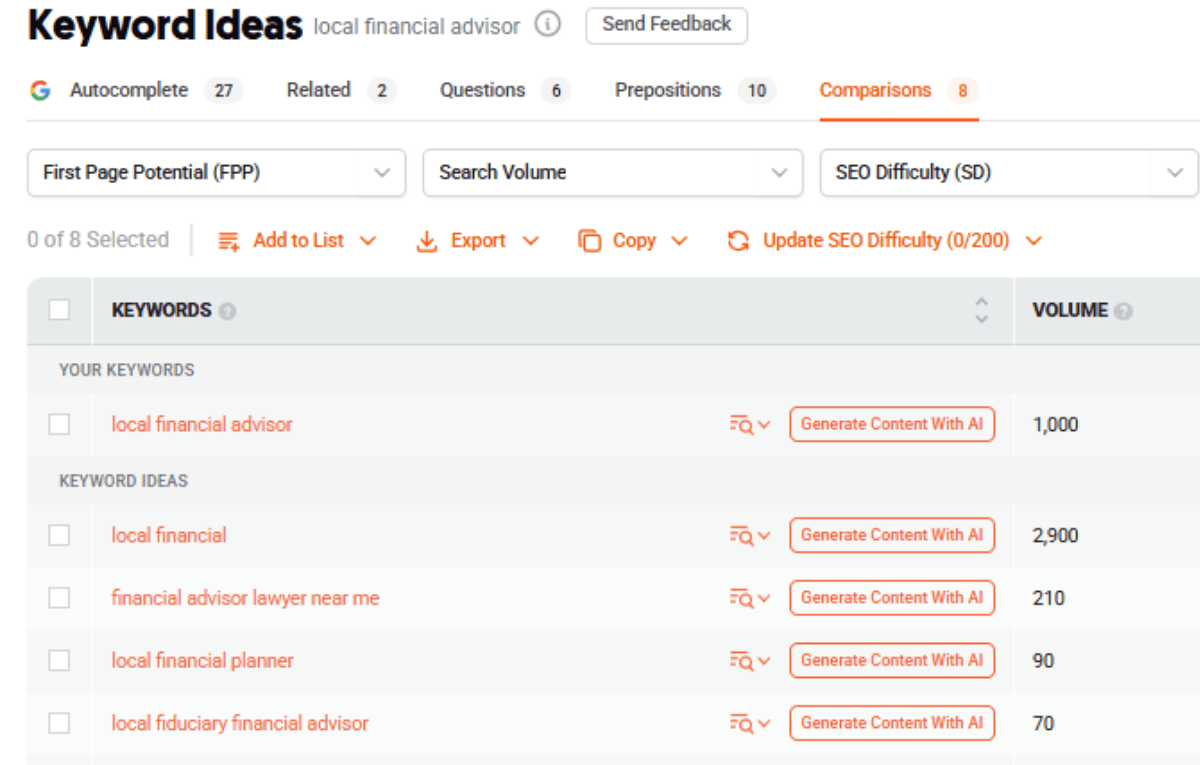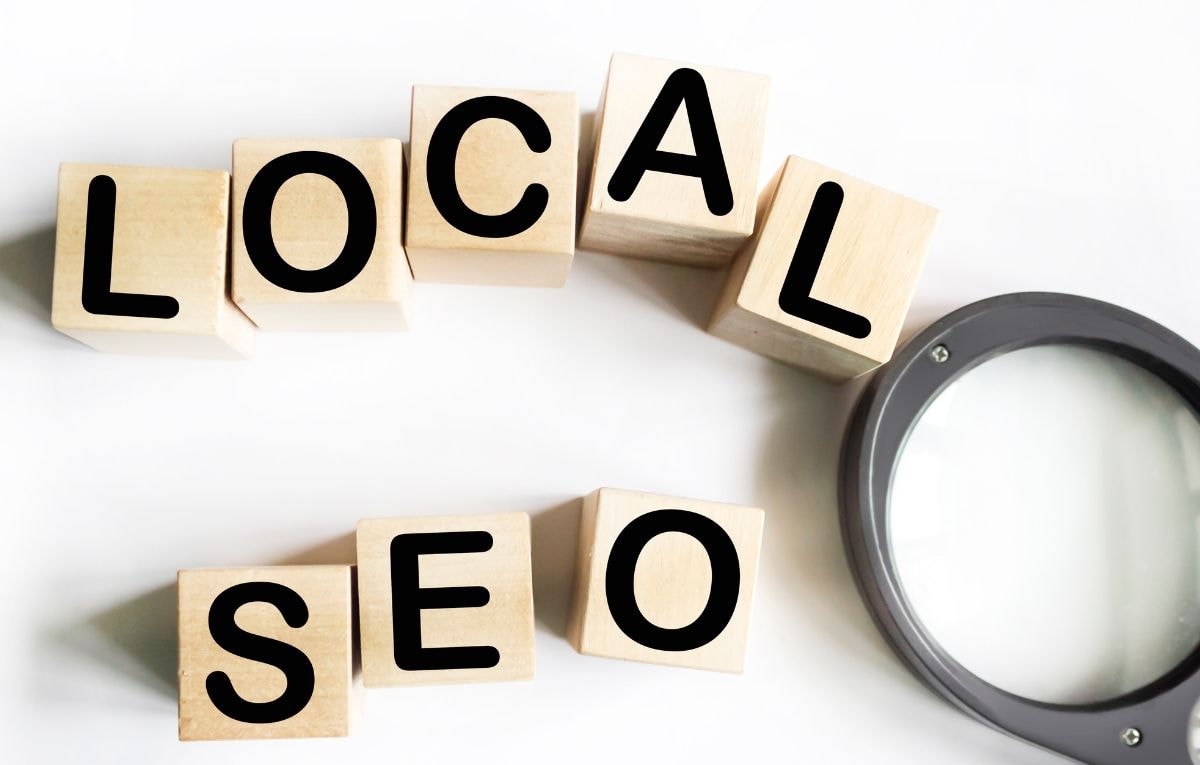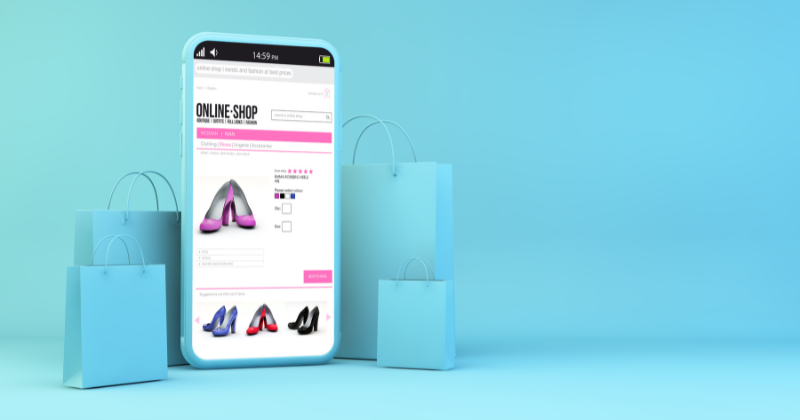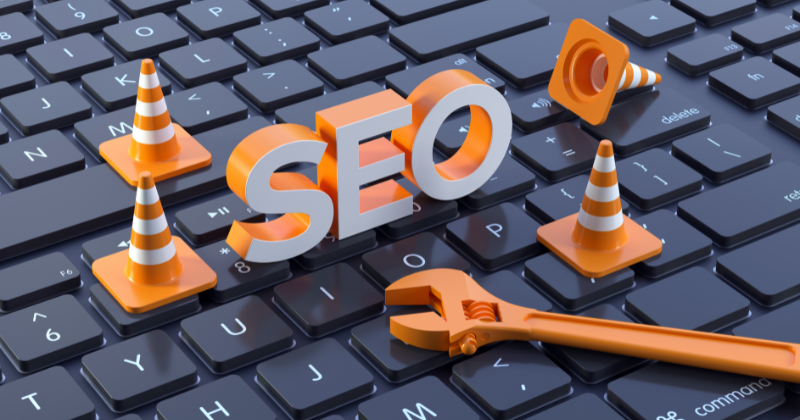Essential Guide to Search Engine Optimization for Financial Advisors
In a world where your next client is one Google search away, mastering search engine optimization (SEO) isn’t just a good idea, it’s vital.
If you’re a financial advisor trying to grow your practice, your website can either work for you or against you. This blog is your ultimate guide to getting found online, reaching prospective clients, and building a rock-solid digital presence.
A strong local SEO strategy helps you dominate your area, especially with a well-optimized Google Business Profile. SEO success isn’t a mystery, it’s about consistency, good tools, and avoiding common pitfalls.
Key Takeaways
1. Stop Competing on Broad Terms, Own the Niche Instead
Forget “financial advisor” go all in on long-tail keywords like “retirement planning for dentists” or “wealth advice for Gen X.” Why? They convert better, rank faster, and speak directly to your ideal client.
2. Local SEO Is a Growth Engine, Not a Checkbox
If your website isn’t fully optimized with keywords, reviews, Q&As, schema, call to action buttons, internal links, and damn good content, you’re leaving money on the table. Dominate your niche by starting with the basics and growing effectively.
3. Content Without E-EAT Is Just Noise & No One Will See It Or Care About It
If your blogs don’t show experience, authority, and trust, you won’t rank, and you won’t convert.
Real insights > generic advice. Add client stories, local references, and credentials that prove you’re the expert.
Why Should Financial Advisors Care About SEO?
Let’s kick things off with the basics.
Search engine optimization is the practice of making your website more attractive to search engines like Google, so it appears higher on search engine results pages (SERPs). [source]
When done right, it connects you to people actively searching for your services, such as retirement planning, investment advice, or help with budgeting.
Now, you might be thinking, “I’ve already got a website.” Great, but can anyone find it?
That’s where SEO for financial advisors comes in.
It’s about using specific keywords, crafting high-quality content, and building trust signals that boost your visibility to potential clients.
In the financial services industry, trust is everything. So is being seen as an expert. An effective SEO strategy helps position your brand as both.
Keyword Research and Planning

Here’s where the magic starts: keyword research.
You want to target relevant keywords that your prospective clients are actually typing into search engines.
For example, “best financial advisor for retirement planning” or “local financial planner in Florida”. These are called long-tail keywords, and they often convert better than broad terms.
Use the keyword research tools below to search for relevant keywords [source]:
✅ Google Keyword Planner
✅ Ubersuggest
✅ Ahrefs
✅ SEMrush
Don’t forget to look at search volume and keyword difficulty. You want terms with enough traffic, but not so competitive that you’ll never rank.
💡Bonus tip? Spy on what your competitors are ranking for and find gaps in their content strategy.
This stage forms the blueprint of your entire SEO efforts.
Get this wrong, and your content could be targeting the wrong audience entirely.
On-Page Optimization
Time to polish up what’s already on your site. This is called on-page SEO, and it includes things like:
✅ Adding your specific keywords into the page title, meta description, headers (H1, H2s, etc.), and image alt tags
✅ Creating valuable content that speaks directly to your audience’s needs
✅ Linking between your web pages to guide visitors (and search bots) around your site
✅ Using clear formatting, mobile-friendly design, and fast load speeds
Your website content should be built with humans in mind, but structured in a way that search engines can easily understand.
Every page should answer a question or solve a problem for your potential clients.
💡Pro tip: Creating content that is evergreen (always relevant) saves you time and continues to attract traffic over the long term.
Local Search Engine Optimization

Local SEO is your best friend if you serve clients in a specific city or region.
Start by claiming and optimizing your Google Business Profile.
Add business hours, services, a strong description with relevant keywords, and ask happy clients to leave reviews.
Next steps:
✅ Use local search terms like “financial advisor in Orlando” or “wealth management firm in Miami”.
✅ Join local business listings and online directories.
✅ Write blog posts or guides that focus on regional financial news or advice.
Why is this important? Because when someone nearby types “financial advisor near me” into Google, you want to pop up in the local search results, not be buried under ten competitors. [source]
Technical SEO
This part sounds intimidating, but it’s mostly about user experience.
Technical SEO ensures that your website is healthy, crawlable, and speedy.
Google (and your visitors) love:
✅ Mobile-friendly design for mobile devices
✅ Fast-loading pages
✅ Secure websites with SSL (that little padlock in your URL)
✅ Clear navigation and internal links
✅ No broken links or duplicate content
Use Google Search Console to monitor your site’s health and track how well your SEO efforts are paying off.
It also helps you fix any technical issues that might be dragging down your search engine rankings.
Building Your Online Presence

Beyond your website, how visible are you online?
Building a strong online presence means showing up consistently in multiple places.
Here’s how to do it:
✅ Use social media to share valuable insights, blog articles, and industry news.
✅ Join Facebook groups or Reddit forums related to the financial services industry:
✅ Get featured on authoritative websites or contribute guest blog posts.
✅ Connect with other websites through backlinks (Google loves it when trusted sites link to you).
The more connected and active you are online, the more trust and authority you build in the eyes of both Google and your audience.
SEO for Financial Planning

Now, let’s talk specifically about SEO for financial planning.
If your financial advisory practice helps people plan for their future, you’ve got loads of SEO gold to work with.
Think about content like:
✅ “How much should I save for retirement at 40?”
✅ “Investment advice for young professionals”
✅ “Should I get a financial advisor before I get married?”
These are the questions potential clients are asking, and your website should be answering them.
Use specific keywords in your blog titles and page headers, and don’t forget about local SEO here, too.
Someone searching “financial planner in Key West” should find you on the first page of search results.
Creating high-quality content and building quality backlinks will boost your SEO rankings and help your practice attract qualified leads.
Measuring SEO Success
If you’re going to put effort into SEO, you’ll want to know what’s working. This is where tracking comes in.
Use Google Analytics to understand:
✅ Where your visitors are coming from
✅ Which pages they’re viewing
✅ How long they are staying
✅What actions they’re taking (e.g., filling out a contact form)
Pair that with Google Search Console to track:
✅ Which search terms you are showing up for
✅Your keyword rankings
✅Click-through rates from search engine results pages
SEO is a long game, but watching your progress helps you make smarter moves. Adjust your SEO strategy based on what the data tells you.
Avoiding Common SEO Mistakes
It’s easy to trip up when you’re starting out with SEO. Here’s what to avoid:
✅ Keyword stuffing, shoving your target terms into every sentence, is a big no-no.
✅ Using duplicate or thin content
✅ Ignoring mobile optimization
✅ Buying shady backlinks
✅ Skipping your meta description or not using a relevant page title
Stay updated on the latest trends. SEO consultants and blogs (like this one!) can keep you in the loop.
Remember: real, useful content for your audience will always win out over shortcuts.
Summary
Search engine optimization for financial advisors isn’t just a technical add-on. It’s how your financial advisory firm stands out online, attracts more qualified leads, and grows your business sustainably. Whether you’re just getting started or refining your current approach, the right mix of SEO services, content, and tracking can help you increase search engine results and reach the people who need your help.
Feeling Overwhelmed?
If all of the above has got you stressed, don’t panic, ZuluShack Creative is here to save the day. Our SEO services are designed to help financial professionals like you rise above the noise and rank where it counts. Let us take care of the technical stuff so you can focus on what you do best, providing top-tier financial advice.
Frequently Asked Questions
1. How long does it take for SEO to work for financial advisors?
Typically, you’ll start to see results in 3–6 months, but it depends on your industry, competition, and how much content you’re producing. SEO is a long-term game that builds momentum over time.
2. Should I use paid ads instead of SEO?
Paid ads can provide short-term traffic, but SEO for financial advisors offers a more sustainable and cost-effective way to attract potential clients over the long term. Ideally, both should be used in a balanced digital marketing strategy.
3. Is it worth hiring an SEO expert for my financial planning practice?
Yes, especially if you’re too busy to handle SEO yourself. A good SEO agency can build a tailored plan for your financial advisor business, help with keyword research, technical SEO, and monitor your progress.
4. What’s the best content to create for SEO?
Focus on blog posts, guides, and FAQs that answer your clients’ most common questions — especially those related to retirement planning, investment advice, and local search queries.
5. Do I really need local SEO if I offer virtual services?
Absolutely. People still use terms like “financial planner near me” even when searching for virtual advisors. Local SEO helps boost your presence in local search results, which can translate into qualified leads.
Mastering How to Rank in ChatGPT: 7 Essential Strategies for Success
The internet is changing, and so is the way people search. With AI platforms like ChatGPT on the rise, traditional search engines just aren’t cutting it anymore. But don’t stress, we’ve got your back. This guide will show you exactly how to rank in ChatGPT and stay ahead of the competition by using our digital marketing services.
ChatGPT answers questions directly, not with a list of links. However, links to brands are given, which is why today branded search is such a huge ranking factor compared to years ago.
Ranking depends on content relevance, quality, and clarity. Same as with humans.
Writing in natural language helps improve visibility in AI search results. You can see what Google thinks your page is about on its Natural Language API demo.
You need different SEO strategies for AI search engines. Its being called Ask Engine Optimization.
Key Takeaways:
- Understand How ChatGPT Ranks Content
Focus on user intent and write natural, relevant content that directly answers real questions. - Optimize Content with Structured Data
Use schema markup and maintain fast, mobile-friendly pages to help AI understand and surface your content. - Focus on Content Quality and User Needs
Create useful, scannable content with real value that solves problems and keeps users engaged. - Answer Questions the Way ChatGPT Does
Write in a conversational tone with clear formatting and actionable answers, like ChatGPT’s response style. - Use Smart Link Building (Without Spamming)
Earn trust by building branded and topical backlinks through high-quality guest posts and media mentions. - Build Engagement with User-Generated and Interactive Content
Boost dwell time and trust by encouraging user interaction through polls, comments, and community-driven content. - Promote Your Content with SEO and Content Marketing
Blend traditional SEO with AI-specific optimization to stay relevant in both search engines and generative platforms.
What Makes ChatGPT Different from Traditional Search Engines?

ChatGPT is an AI platform that gives direct answers to user queries, no link lists or endless scrolling required. It’s being referred to as a “generative engine” because it generates a response and not a list.
Unlike traditional search engines that throw a bunch of links your way, ChatGPT gets straight to the point. It pulls content from high-quality, relevant sources that AI systems or APIs from other search engines have indexed. [source]
This means ranking on ChatGPT isn’t your typical SEO game, it’s a whole new ballpark.
To rank here, forget about keyword stuffing and focus on creating content that genuinely matches user intent.
You need to be able to craft content that speaks naturally, answers questions directly, and give real value.
Let’s take a look at how you can do this.
1. Understand How ChatGPT Ranks Content
It’s All About User Intent and Relevance
To rank on ChatGPT, you need to think like the AI itself. (Welcome to 2025, where we are trying to think like the machine that’s trying to think like us).
ChatGPT’s mission? Reverse engineer user intent and deliver the most relevant content. Here’s what that means for you:
- Write content using natural language (keep it real).
- Focus on answering the user’s question clearly (no fluff).
- Use structured writing that flows like a conversation (make it easy to follow).
Forget the usual SEO rules. While traditional search engines like Google care about backlinks and page speed, ChatGPT’s all about content quality, relevance, and how well it nails user intent. [source]
So, make sure your content is not just good, but exactly what the user needs.
AI-Driven Answers Are Based on Content, Not Just Links
Unlike traditional search engines, ChatGPT isn’t all about backlinks or domain authority. Nope, it’s got a different set of priorities. Instead, it focuses on:
✅ Relevant material (keep it meaningful)
✅ Up-to-date content (nobody likes outdated info)
✅ Natural language processing signals (speak the language of the AI)
If your content is top-notch and genuinely solves user problems, you’re more likely to see it pop up in those shiny AI-generated responses. So, keep it fresh, keep it relevant, and keep it real.
2. Optimize Content with Structured Data
Add Structured Data and Schema Markup
Even though ChatGPT doesn’t crawl websites like Google does, structured data is still vital when AI platforms pull data from search engine results.
It’s like giving your content a roadmap to help AI systems find and understand it faster.
This is where schema markup comes in. Think of this as a backstage pass for your content. [source]
Schema helps your content get indexed by AI tools, making it easier for them to figure out what your page is all about.
The result? Your content gets seen and understood, making it more likely to show up in those AI-generated answers.
So, don’t skip this step, it’s the secret ingredient for better AI visibility.
Top Tip:
Add schema markup to blog posts, service reviews, and product pages to help AI-driven searches understand the context of your content.
Make Your Site Responsive and Fast
A responsive site with lightning-fast page speed doesn’t just make your users happy, it also gives you a big ol’ thumbs-up from both traditional search engines and AI platforms.
It’s like rolling out the red carpet for both your audience and the algorithms.
The faster and smoother your site runs, the better the chances of ranking higher, whether it’s Google or ChatGPT checking you out.
Speed matters so don’t let your site get stuck in traffic!
3. Focus on Content Quality and User Needs

Create Content That Delivers Real Value
The best way to rank on ChatGPT? Simple, create content that actually helps people.
Whether you’re answering a burning question or offering a solid solution, your content should always be focused on what the user really needs.
Here’s how to make it happen:
✅ Use clear headings and bullet points (nobody has time to read a wall of text).
✅ Write in natural language (keep it real, keep it friendly).
✅ Include multimedia content (images, videos, infographics) to keep things engaging.
If you nail these, you’ll be serving up content that’s not only helpful but totally irresistible to AI and your readers!
Structure for Easy Scanning
Want to take your content to the next level? Add some interactive components like dropdowns or tabs.
Not only will they boost engagement and keep users hooked, but they also make your content a breeze for AI tools to reference in those instant responses.
AI loves content that’s clear and structured, so when your content is organized with interactive features, you’re giving the AI exactly what it needs to pull your info quickly and effectively.
It’s like setting up a VIP lane for your content in the AI world!
4. Answer Questions the Way ChatGPT Does
Mimic the Conversational AI Format
Since ChatGPT loves to deliver answers in a friendly, conversational tone, you should be doing the same.
ChatGPT isn’t here for stiff, formal language, it wants the vibe to be casual and approachable, so your content is more likely to be included in AI-generated answers.
✅ Write clearly and conversationally (no keyword stuffing)
✅ Use concise intros, bullet points, and structured data
✅ Include original data, stats, and case studies
✅ Back everything with strong formatting and schema
Example:
Instead of saying:
“Social media marketing is a digital strategy used by businesses.”
Try:
“Wondering how social media can boost your business? It’s a simple yet powerful strategy used by thousands of brands every day.”
Include Real-Time, Actionable Content
Using real-time data and linking to authoritative sources makes your content more trustworthy.
When AI tools pull data for responses, they’re more likely to go for content that’s fresh, accurate, and credible.
So, if you want to be the go-to for AI-generated answers, keep it relevant and reliable!
5. Use Smart Link Building (Without Spamming)
Guest posting on high-authority sites is a killer way to boost your visibility and rank on ChatGPT.
You’re not just getting your name out there, you’re building credibility with AI platforms too.
Just make sure your posts are packed with relevant content and sprinkle in some brand mentions or links to your own material.
Target anchors: Include any word from your keyword
✅ Branded anchors: Your business/website name
✅ URL anchors: The actual link (naked URL)
✅ Topical anchors: Broader topic of your page
✅ Misc anchors: “Click here,” “this website,” etc.
The more AI sees you as a trusted source, the more likely it is to reference you in those sweet, AI-generated answers.
HARO is dead. Kind of.
We now use HARO, Qwoted, Featured, Help a B2B Writer, and Twitter alerts to get in front of journalists. [source]
Here’s how we build authority in 5 steps:
✅ Pre-written pitch templates tailored by niche
✅ AI + human hybrid to instantly rewrite for each query
✅ 3-sentence quote limit (clear, quotable, credentialed)
✅ Track all wins by author and publication for E-E-A-T
✅ Repurpose quotes into blog content + LinkedIn carousels
Result? Branded links. AI trust. And sometimes even podcast invites.
Instead of trying to compete with DR90 giants, we recommend going deep on one narrow slice of your niche. This gives you the highest chance of being pulled into AI Overviews or chatbot answers, even with a DR 30–40 domain.
Affiliate Sites
Affiliate sites are a goldmine for reaching new audiences, but don’t just throw your name on any random site.
Make sure they’re legit and align with your niche.
The right affiliate partnership can help extend your reach and boost your AI cred, so choose wisely and get your content in front of the right crowd!
6. Build Engagement with User-Generated and Interactive Content
Engagement Metrics Matter
Both AI search engines and traditional search engines keep an eye on how users interact with your content.
If people are sticking around, clicking, commenting, or sharing, it’s a clear signal that your content is hitting the mark and providing real value.
Boost Engagement By:
✅ Adding polls, quizzes, and surveys (who doesn’t love a little interaction?).
✅ Encouraging comments or user mentions (let’s get the conversation going).
✅ Highlighting feedback from niche communities (it’s all about those loyal fans).
User-generated content is like a golden ticket to boosting your brand’s reputation and visibility across AI-driven platforms.
The more engagement you get, the more AI takes notice, so make sure you’re giving your audience a reason to stick around and get involved!
According to Matt Diggity, AI users convert better. “AI-referred sessions average 10.3 minutes compared to 8.1 minutes from Google Search… AI users land on your site already primed with context.” [source]
7. Promote Your Content with SEO and Content Marketing

SEO isn’t dead – it’s just evolving.
To rank on ChatGPT and traditional search engines, you’ve got to mix the best of both worlds.
That means blending tried-and-true SEO strategies with fresh tactics tailored for AI platforms.
Traditional SEO Strategies Include:
✅ On-page optimization, which includes keyword research, content optimization, etc. (yes, they still matter).
✅ Off-page Optimization, which includes link building, social media marketing, and reputation management, etc. (don’t forget the basics).
Modern Tactics Include:
✅ Optimizing for AI search engines (AI is the future, after all).
✅ Ensuring conversational AI understanding (speak the AI language).
Keep Content Up to Date
Content that’s stuck in the past won’t cut it in today’s fast-paced digital world.
Regularly refresh old content with new stats, real-time data, and industry updates.
This keeps AI systems happy and signals that your content is fresh and ready to rank in those AI-generated responses.
Keep it current, keep it relevant, and you’ll stay ahead of the game!
Bonus Tip: Make Your Marketing Strategy ChatGPT-Friendly
To succeed in today’s digital marketing landscape, you’ve got to align your entire strategy with how people actually search.
That means crafting every blog post, service page, and product description with AI-readability in mind.
It’s not just about appealing to the algorithms; it’s about speaking the same language as your audience and the AI platforms that are now doing the searching.
Tips to Make Content ChatGPT-Ready:
✅ Break content into diverse formats like Q&As, how-tos, and checklists (keep it dynamic).
✅ Use conversational language and answer specific user queries (ditch the jargon, keep it friendly).
✅ Provide valuable insights, not filler content (AI knows when you’re fluffing it).
Summary
Ranking in ChatGPT goes beyond traditional SEO, it’s about understanding user intent and creating content that directly answers their needs.
As AI-driven platforms like ChatGPT continue to rise, adapting your content strategy is essential. Focus on natural language, structured data, and valuable insights to boost your visibility.
So, create content that genuinely solves problems and meets user needs, and you’ll be well on your way to ranking on ChatGPT and other AI-driven platforms.
Need help creating content that ranks on ChatGPT and other AI platforms? Our expert team knows exactly how to create content that not only drives results but also gets you noticed. Contact us today and let’s get things ranking!
FAQs: Ranking in ChatGPT and AI Search Engines
1. Which AI engines can you rank on?
You can rank content on several AI engines and generative search platforms — here’s a breakdown of the major players you should be optimizing for right now: ChatGPT (OpenAI + Bing API), Google AI Overviews, Perplexity.ai, You.com.
2. What is the difference between ranking in ChatGPT and traditional search engines?
Traditional search engines like Google and Bing rank based on backlinks and page speed. ChatGPT uses natural language processing and content quality to generate answers, focusing on user intent.
3. How do I make my content more likely to appear in ChatGPT answers?
Write clear, structured content using natural language. Answer specific user queries with relevant, up-to-date information and authoritative sources.
4. Does ChatGPT use SEO signals like backlinks or domain authority?
ChatGPT doesn’t rely on backlinks like traditional search engines. It values relevant, high-quality content that aligns with user intent.
5. Can AI tools like ChatGPT replace traditional SEO strategies?
No, but they change how we approach SEO. Focus on content quality and clarity to rank in both traditional search engines and AI systems.
What is GEO? Understanding Generative Engine Optimization
You’re putting in the work to create some top-notch content, but it’s not getting the visibility it deserves.
Just when you think things couldn’t get more complicated, AI driven search engines show up.
We get it. But this is the future of search engine optimization. This is the future of branding online. This is the future period.
AI-driven search engines are taking over, and your content can’t just check SEO boxes anymore.
It has to connect with how these AI systems understand, rank, and serve your content to users. It’s all about relevance.
That’s where Generative Engine Optimization (GEO) comes in!
Generative Engine Optimization (GEO) helps your content perform better with AI search engines.
It. It’s similar to ranking on traditional search engines, but not exactly the same.
In the blog below, we’ll answer your GEO questions, how it works, and why it’s becoming a game-changer in modern digital marketing.
Key Takeaways
- Relevance Engineering Over Traditional SEO – Brand Marketers should evolve into “relevance engineers,” focusing on:
- Information retrieval: How do AI search engines find your content and is it relevant to the user’s question? Does your website cluster content into categories and sections that are easy to understand, and how easy is it to read?
- NLP Content Strategy: You need to adopt a confident tone, provide citations, highlight relevant statistics, and ensure readability and clarity.
- Digital public relations (PR): Where can AI engines find your brand being mentioned?
- Structured Data as a Secret Weapon – Embedding key content within structured data formats, such as Schema.org, gives AI search engines the ability to extract and utilize information effectively.
- Embracing Generative Engine Optimization (GEO) – GEO involves tailoring content to be more accessible and valuable to LLMs by:
- Adopting an authoritative tone and providing citations
- Highlighting relevant statistics
- Ensuring readability and clarity
- Influencing Retrieval-Augmented Generation (RAG) Systems – RAG systems can be guided through “semantic trickle” by phrasing content in straightforward subject–predicate–object formats, making it easier for AI to extract meaningful information.
What is Generative Engine Optimization (GEO)?

Generative Engine Optimization (GEO) is about tailoring your content and website specifically for AI-driven search engines. Engines like Google AI Overviews, ChatGPT, and Perplexity.
At its core, GEO helps your content reach more people on more platforms so that more users come to your website. More traffic, more trust, more conversions.
GEO ensures your website isn’t just discoverable, but also well-represented by AI-powered engines that are shaping the future of search.
Recommended Tools and Tactics
- ZipTie: Tracks AI overview visibility across queries
- Profound: Monitors generative search presence
- CrUX + Core Web Vitals: Ensures pages are fast and indexable
- Schema.org: Implements rich structured data
- Google DOJ Documents: Provides insights into Google’s values and priorities
More and more people are using AI-driven search engines, which means that businesses must adapt their digital marketing strategies to include GEO. It’s not just the latest trend, it’s the future of search. Unlike traditional search engines, AI engines focus on contextual relevance.
Traditional search engines are changing… heck they’ve changed a lot in the past 12 months already. But they aren’t slowing down.
Unique Aspects of Generative Engine Optimization

✅ Built for AI comprehension:
Generative Engine Optimization (GEO) uses natural language processing (NLP) to structure content in a way that’s easy for AI to understand, summarize, and present.
✅ Goes beyond keywords & backlinks:
GEO prioritizes relevance, clarity, and trustworthiness over keyword density. You have to prove that you can be trusted through content quality, citations, statistics, sources, authorship, and real Subject Matter Expert insights.
✅ Optimizes for synthesis, not just rankings:
Rather than optimizing solely for SERP position, GEO ensures your content is the kind that AI systems pull into their AI generated responses.
✅ Blends SEO + GEO for maximum reach:
The best strategies combine traditional SEO techniques like keyword research with GEO’s adaptability, ensuring your message gets seen, clicked, and trusted by both people and AI.
As AI-generated search continues to rise, GEO helps ensure your content remains competitive, discoverable, and aligned with evolving user behavior. And hey, that’s exactly what we want.
GEO In The Wake Of The Search Engine Volume Drop

Gartner predicts that search engine volume will drop by 25% by 2026. All thanks to AI chatbots and other virtual agents.
As users are flocking to platforms like ChatGPT, Perplexity, and Google AI Overviews for direct and comprehensive responses. So what? Well that means your content needs to be optimized not just for humans, but for how machines read, retrieve, and respond.
✅ GEO ensures your brand remains visible and trusted in an AI-first world.
✅ It helps your content become the source AI models quote, summarize, and surface.
✅ And it builds a stronger, smarter brand presence, wherever your audience asks questions.
💡 Leading digital marketing agencies are already shifting strategies, building content with GEO principles to thrive in this new search landscape.
If you want your content to shine where search is heading, GEO is the strategy to bet on.
The Natural Evolution of GEO

1. From Keywords to Concepts
- SEO focused on matching keywords to user queries.
- GEO focuses on matching concepts and context to AI model outputs.
Instead of asking, “What keyword do I want to rank for?” GEO asks, “What’s the best way to teach an AI to use my content as the answer?”
2. From Pages to Passages
- SEO traditionally optimized whole pages.
- GEO methods optimize semantic chunks (passages of 50–150 words) so that large language models (LLMs) can easily extract information.
Think: clear headings, concise answers, and logical flow. Every paragraph matters.
3. From SERPs to AI Overviews
- SEO lived and died on blue links in the Search Engine Results Page (SERP).
- GEO competes for inclusion in AI Overviews and generative answer engines like:
- Google SGE
- ChatGPT
- Perplexity
- Bing Copilot
In GEO, your content isn’t just trying to rank, it’s actually trying to be quoted or cited in AI’s response. That’s a whole different ball game.
4. From Optimization to Relevance Engineering
- SEO was about relevant keywords, structure, tags, and links.
- GEO is about training LLMs to recognize your content as trustworthy, structured, and useful.
This includes:
- Structured data (schema)
- Subject-matter expertise
- Cited sources
- Conversational tone with depth
So, What Do You Do Differently With GEO?
- Create AI-friendly content that uses clear subheadings, concise answers, and structured formats.
- Use E-E-A-T principles aggressively (Experience, Expertise, Authoritativeness, Trust).
- Focus on brand search volume and entity recognition.
- Monitor your presence in AI tools, not just in Google SERPs.
- Publish content that AI models want to reference, not just humans.
GEO vs. Traditional SEO: Key Differences

GEO ensures your content is picked up and used by AI-driven tools, not just trying to rank higher in traditional search results. [source]
The focus is on optimizing content for AI-driven search engines like Google AI Overviews, ChatGPT, and Perplexity. You wouldn’t do the same things to boost your rankings as you would with traditional SEO, but they are quite similar.
It emphasizes the quality of your content and how it’s structured. It’s less about playing to the AI algorithms and traditional search engine formats and more about making your content easy for AI to understand and use.
GEO is designed for the new wave of AI-powered searches that don’t just list links – they pull together information from multiple sources and deliver it to intended audiences effectively as AI generated results.
Traditional SEO practices focus on optimization strategies like keyword placement.
GEO vs. Traditional SEO: Key Similarities

Both SEO and GEO are focused on the same big goals: getting your content seen and engaging your audience.
Both approaches rely heavily on unique, relevant content because quality matters.
And that’s the case whether you’re optimizing for AI tools or traditional search engines. It’s all about creating content that meets user expectations and delivers real value. It’s as simple and as difficult as that.
Both also use similar techniques, like keyword targeting and content creation optimization, to improve search rankings.
Traditional SEO tracks keyword performance, is more focused on search volumes and impressing search engine algorithms. On the other hand GEO focuses on helping AI-driven tools understand and use your content effectively.
So, whether you’re going the SEO route or diving into GEO, you’re ultimately working toward the same thing: boosting your website’s visibility and driving more organic traffic.
How Generative AI Engines Work

- Massive Data Training – Generative AI models like ChatGPT and Gemini are trained on vast datasets, powering AI-powered search engines with data from books, articles, and websites.
- Pattern & Context Recognition – AI learns language patterns, improving organic search metrics by providing natural, relevant responses based on context.
- Multi-Source Input – These search technologies pull information from diverse sources and structured data, boosting organic search traffic by delivering accurate and comprehensive responses.
- Powered by Large Language Models (LLMs) – LLMs use machine learning techniques like transformers, helping AI-powered search engines generate relevant, high-quality content.
- Contextual Understanding – AI understands word relationships in context, enhancing organic search metrics by providing human-like comprehensive answers.
- Input Encoding & Output Decoding – User input is processed into structured data, improving SEO and organic search traffic expected through optimized content generation.
- Intelligent Synthesis – AI synthesizes information across multiple sources, creating concise, relevant content that drives other organic search metrics.
- User Intent Matching – AI aligns responses with user behavior and search intent, essential for GEO strategies and improving organic search metrics.
- Search Behavior Influence – As AI understands user needs better, it reshapes organic search and content visibility, boosting search traffic.
- Human-Centric Output – The goal is to generate human-centric content that aligns with user expectations, improving organic search metrics and engagement.
Measuring GEO Performance

To gauge how well your content is performing in AI-driven search results, focus on these indicators:
- Visibility in AI Responses – Monitor how often your content appears in AI-generated answers.
- User Engagement Post-Referral – Assess how users interact with your site after arriving via AI platforms.
- Brand Authority Perception – Evaluate how AI-driven platforms perceive your brand’s authority.
- Utilizing UTM Parameters for AI Traffic – Implementing UTM parameters helps track the source of your AI referral traffic.
- Establishing Benchmarks and Continuous Monitoring – Set initial benchmarks for these metrics and regularly compare them against industry standards.
Future Of Generative Engine Optimization
As AI-driven search engines evolve, search engine optimization tactics like keyword stuffing are becoming less effective. The rise of generative AI has led to a significant shift in how content is created and consumed. According to McKinsey, 65% of organizations now regularly use generative AI, nearly double the adoption rate from the previous year.
The future of GEO lies in continuous adaptation and innovation. By embracing the capabilities of generative AI and aligning content strategies with the evolving landscape, businesses can ensure their content remains visible, relevant, and impactful in AI-driven search results.
As AI and answer engines continue to dominate search engine results pages (SERPs), integrating GEO strategies into your digital marketing strategy is important for staying competitive in an increasingly AI-powered world.
Frequently Asked Questions
How does GEO differ from traditional SEO?
GEO differs from traditional SEO by focusing on content quality and structure for AI platforms, aiming to meet user intent and create better conversational experiences, not just target keywords.
Why is GEO important in modern search?
GEO helps AI platforms deliver more relevant, personalized results by considering location, context, and user intent, ensuring accurate, timely responses.
What are some key strategies for optimizing content for GEO?
To optimize for GEO, use structured data, authoritative content, and language that aligns with AI models, boosting visibility, engagement, and relevance to user intent.
How can I measure the performance of my GEO efforts?
Track GEO performance by monitoring AI visibility, post-referral engagement, brand mentions, and UTM-tagged traffic, ensuring your content meets user intent via AI and answer engines.
15 Mobile SEO Best Practices for a Better User Experience in 2025
Have you ever tried searching for something on your phone only to land on a website that takes forever to load?
Frustrating, right? A slow, clunky website can drive customers away in today’s mobile-first world.
That’s where mobile SEO comes in.
Optimizing the site for mobile devices can ensure a smooth, enjoyable experience that keeps users engaged.
This article explores 15 mobile SEO best practices to boost search engine rankings and create a stellar user experience.
Let’s dive in!
TL;DR:
To rank well on mobile searches in 2025, the website must be fast, responsive, & easy to navigate on any device. Prioritize page speed, optimize images, and use Google Search Console to monitor your site’s mobile performance and improve your Google rating. Remember to make your content concise and easy to read on smaller screens.

What is Mobile SEO and Why is it Important in 2025?
Mobile SEO is the simple process of optimizing your website for mobile users.
With more people than ever using their mobile devices to access the Internet easily, it’s crucial to have a mobile-friendly site that provides a positive user experience.
Effective mobile optimization can lead to higher rankings in mobile search results, increased mobile traffic, and more conversions.
That’s why mobile SEO [is] essential.
1. Prioritize Page Speed
I can’t stress enough how vital page speed is for mobile sites.
Have you ever abandoned a website because it took too long to load on your phone?
I know I have! Mobile users are incredibly impatient, so ensure your mobile site loads quickly to avoid high bounce rates.
Tools like Google’s PageSpeed Insights can help you identify areas for improvement.
Aim for a page load time of less than three seconds.
A fast-loading mobile site can also improve your Google rating, leading to better visibility in search results.
Google considers page speed a ranking factor, so optimizing your site’s performance is crucial for attracting more organic traffic.

2. Optimize Mobile Images
Substantial image files can significantly slow down your mobile site.
Continually optimize your images by compressing them without sacrificing quality.
This will improve page speed and the overall user experience on your mobile-friendly site.
Consider using modern image formats like WebP, which offer better compression than JPEG or PNG.
3. Use Responsive Design
A responsive design ensures the website adapts seamlessly to any screen size, providing a consistent experience for both mobile users and desktop users.
This is essential for optimal viewing and navigation on all devices.
Avoid using separate URLs for your site’s mobile and desktop versions, as this can create duplicate content issues.

4. Don’t Block Crucial Resources
While blocking CSS and JavaScript might seem like a good idea to improve loading times, this can actually harm mobile SEO.
Search engines must crawl these files to understand your website’s content and structure.
Blocking these resources can also lead to a poor user experience, with broken functionality and distorted layouts.
5. Use Google Search Console
Google Search Console is a most valuable (and free!) tool that provides insights into how your mobile site performs in mobile searches.
It can help you identify and fix mobile SEO issues affecting the rankings.
Pay close attention to the Mobile Usability report, which highlights specific problems like text that is too small to read or clickable elements that are too close together.

6. Mobile-Friendly Test
This might seem obvious, but you’d be surprised how many websites still need to be mobile-friendly.
Use Google’s Mobile-Friendly Test tool to see how your site [is] mobile-friendly and identify areas for improvement.
This tool simulates how a user would experience your site on a mobile device and provides specific recommendations for optimization.
7. Easy Mobile Navigation
Navigating a website on a small screen can be very challenging.
Keep your mobile site’s navigation simple and intuitive to ensure a user-friendly experience.
Use a clear and concise menu structure, and consider implementing a “sticky” menu that remains visible as the user scrolls down the page.

8. Mobile-First Indexing
Google predominantly uses the mobile version of the website for indexing & ranking.
This means that having a strong mobile site is more important than ever for SEO services.
Ensure the mobile site has the same content and functionality as your desktop site to avoid negatively impacting your search rankings.
9. Avoid Intrusive Pop-ups
While pop-ups can effectively capture leads, they can also be incredibly annoying on mobile devices.
If you must use pop-ups, ensure they are easily dismissable and don’t obstruct the main content.
Consider using less intrusive alternatives like slide-in notifications or banners.

10. Large Font Sizes
Small font sizes can be challenging to read on mobile devices.
Choose an easily readable font size without zooming in.
A font size of at least 16px is generally recommended for body text.
11. Concise Mobile Content
Mobile users typically have shorter attention spans.
Keep your content concise and get to the point quickly to keep them engaged.
Use headings, subheadings, & bullet points to break up your text & make it easier to scan.

12. Use Structured Data
Structured data helps search engines understand the content on your mobile site.
This can lead to better visibility in mobile search results and rich snippets.
Use schema.org vocabulary to mark your content with relevant information like product details, reviews, and events.
13. Consider a Separate Mobile URL
While responsive design is generally preferred, a separate mobile version of your website with a dedicated URL can sometimes be a viable option.
This approach can be helpful for websites with complex functionality or a large amount of content that is difficult to adapt to a responsive design.

14. Don’t Forget Local SEO
Local SEO is crucial for optimizing your mobile site for local searches if you have a local business.
This includes ensuring your NAP (Name, Address, Phone number) is consistent across your desktop and mobile sites.
Also, make sure your business is listed on Google My Business & other relevant online directories.
15. Analyze Your Mobile SEO
Conducting an SEO case study can provide valuable insights into what mobile SEO strategies are working and what areas need improvement.
This data-driven approach can help refine your efforts and maximize your mobile traffic.
Track key metrics like organic traffic, bounce rate, & conversion rate to measure the effectiveness of your mobile SEO campaign.

Why is Mobile SEO Important for Better User Experience in 2025?
In a smartphone-dominated world, ignoring mobile SEO is like ignoring a huge chunk of your potential audience.
Think about it: how often do you use your phone to search for information, products, or services?
Probably a lot! People are constantly on their mobile devices and expect a seamless browsing experience.
If your website could be faster, smoother, and easier to navigate on a mobile device, you risk losing those valuable visitors to your competitors.
By prioritizing mobile SEO, you can ensure the website caters to the needs of mobile users.
It provides a positive experience that encourages them to stay longer, explore more, & ultimately convert into customers.

Final Thoughts
Creating a site mobile friendly is essential in today’s digital world.
More is needed to have a website; you need one that caters to mobile users.
Implementing these 15 mobile SEO best practices can enhance your website’s performance and visibility in mobile search results.
A well-optimized mobile site provides a seamless and enjoyable experience for users, encouraging them to engage with the content and convert into customers.
Think of it as making them feel welcome when they land on your site.
And with the rise of AI, we can quickly expect even more sophisticated tools and techniques to emerge to help us further optimize the mobile experience.
Remember, mobile SEO is an ongoing process.
Continuously analyze your website’s performance and adapt your strategies to stay competitive and user-friendly in the mobile-first world 2025 and beyond.
Frequently Asked Questions
What is the difference between mobile SEO & desktop SEO?
While both aim to improve search engine rankings, mobile SEO focuses specifically on optimizing for searches performed on mobile devices. This includes factors like page speed, responsive design, and mobile-friendly content.
How can my site be mobile-friendly?
Google’s Mobile-Friendly Test is an excellent tool for quickly checking your website’s mobile-friendliness. It analyzes your site and identifies any issues hindering the mobile user experience.
Is it necessary to have a separate mobile site?
Not necessarily. Responsive design, where the website adapts to different screen sizes, is often preferred. However, a separate mobile site might suit complex websites with extensive content.
How long does it take to see results from mobile SEO?
Like any SEO strategy, mobile SEO takes time and consistent effort. You might start seeing improvements in your mobile rankings within a few weeks or months, but achieving significant results often requires ongoing optimization.
What is the best way to improve my mobile site’s page speed?
Optimizing images, leveraging browser caching, and minifying code are effective ways to improve page speed. You can also use tools like Google’s PageSpeed Insights to identify areas for improvement quickly.
13 On-Page SEO for Ecommerce Websites Tips to Boost Sales in 2025
You’ve built a fantastic ecommerce website; it’s user-friendly and filled with great products.
But what if you’re not getting the traffic and sales you expected?
Even the best online stores can struggle without a strong SEO strategy.
That’s where on-page SEO comes in – it’s how you attract search engines and customers to your site.
In this post, we’ll explore 13 powerful on-page SEO for ecommerce websites designed to boost your search rankings and drive sales in 2025.
Ready to attract more customers? Let’s get started!
TL;DR:
To boost your ecommerce site’s sales in 2025, focus on on-page SEO. This means mastering keyword research (using tools like Google Keyword Planner and exploring keyword ideas beyond search volume), optimizing product pages and category pages with relevant keywords and engaging content, improving site speed (technical SEO), and building internal links. Don’t forget to make your site mobile-friendly and track the keyword rankings and organic traffic to measure the success of the ecommerce SEO campaign. Need help? Consider SEO services and explore SEO case studies for inspiration.

What is On-Page SEO for Ecommerce Websites?
1. Master Keyword Research for Ecommerce Sites
Keyword research is the bedrock of any successful ecommerce SEO campaign.
To truly understand your audience and what they’re searching for, go beyond basic keyword tools like Google Keyword Planner.
Explore competitor websites, analyze customer reviews, and delve into industry forums to uncover valuable keyword ideas.
Prioritize long-tail keywords, those longer, more specific phrases that reflect actual search queries.
This granular approach, honed from my own experience optimizing numerous ecommerce sites, is essential for attracting qualified organic traffic to your online store.
Remember, it’s not just about search volume; it’s about finding those keywords that genuinely connect with your ideal customer.

2. Optimize Product Page Titles & Meta Descriptions
Think of your title tags & meta descriptions as your product’s first impression in search results.
They’re your chance to entice clicks and drive traffic. When crafting these crucial elements, clarity and conciseness are key.
Include your target keyword naturally, but don’t stuff it in.
Instead, focus on creating compelling copy that highlights the unique benefits of your product and encourages users to click through to your site.
A well-crafted meta description can significantly improve your click-through rate, leading to increased visibility and potential sales.

3. Write Unique and Engaging Product Descriptions
Ditch the generic manufacturer descriptions! In the competitive world of ecommerce, your product descriptions need to stand out.
Craft unique, informative, & engaging content that speaks directly to your target audience.
Highlight the key features & benefits of your product, using persuasive language that resonates with your ideal customer.

Naturally, incorporate relevant keywords throughout your descriptions, but prioritize readability and user experience.
Remember, you’re writing for humans first, search engines second.
4. Use High-Quality Product Images and Videos
In ecommerce, visuals are king. High-quality images and videos not only showcase your products in the best possible light but also play a significant role in on-page SEO.
Use original, high-resolution images that accurately represent your products.

Optimize them by compressing file sizes without sacrificing quality, and ensure they load quickly to avoid impacting page speed.
Don’t forget to add descriptive alt text to your images, providing context for search engines and improving accessibility for users with visual impairments.
5. Optimize Your Category Page Content
Category pages are more than just lists of products; they’re valuable landing pages that can attract significant organic traffic.
Treat each category page as a dedicated page for a specific product group.
Craft unique, keyword-rich content that provides valuable information about the products within that category.
Consider adding filters and sorting options to enhance user experience and make it easier for customers to find what they’re looking for.
6. Structure Your Site with Clear Navigation and Internal Links
A well-structured website is a win-win for both users and search engines.
Clear, intuitive navigation helps users easily find what they need.
At the same time, a logical site structure with relevant internal links makes it easier for search engines to crawl & index your pages.
Internal linking also helps distribute link equity throughout your site, boosting the visibility of your less prominent pages.
Think of it as creating a roadmap for both your customers and search engine bots to navigate your online store effectively.

7. Improve Site Speed for Better Technical SEO
Site speed is a most crucial factor in technical SEO. In today’s fast-paced digital world, users expect websites to load quickly.
A slow loading site can lead to high bounce rates, frustrated customers, and, ultimately, lost sales.
Optimize your images, leverage browser caching, and minimize HTTP requests to improve page load times.
Google’s PageSpeed Insights is a most valuable tool for identifying areas for improvement & ensuring your site is performing at its best.
8. Implement Schema Markup for Ecommerce SEO
Schema markup is a very powerful tool that helps search engines understand the content on your product pages.
By adding structured data markup to the HTML, you provide context to your data, making it easier for search engines to show rich snippets in search results.
These rich snippets, which can include product information, reviews, and pricing, can significantly improve your visibility and click-through rates.

9. Make Your Website Mobile-Friendly
In the age of mobile commerce, a mobile-friendly website is non-negotiable.
Ensure your online store is responsive, adapting seamlessly to different screen sizes & providing a smooth browsing experience across all devices.
Google prioritizes mobile-first indexing, meaning it mainly uses the mobile version of site for indexing the ranking.
A mobile-friendly site is not just about user experience; it’s a fundamental requirement for effective SEO services.
10. Build High-Quality Backlinks to Your Ecommerce Site
While technically an off-page SEO tactic, building high-quality backlinks is essential for improving your domain authority and search rankings.
Simply focus on acquiring links from reputable websites within the industry, such as relevant blogs, news sites, and industry directories.
Guest blogging, participating in industry forums, & creating valuable content that others want to link to are all effective strategies for building a very strong backlink profile.

11. Track Your Keyword Rankings and Organic Traffic
Monitoring your keyword rankings and organic traffic is crucial for measuring the effectiveness of your ecommerce SEO campaign.
Use tools like Google Analytics & Google Search Console to track the progress, identify areas for improvement, and understand how users are interacting with your site.
Regularly analyze the data to gain insights into what’s working and what’s not, allowing you to refine your strategy and achieve better results.

12. Conduct Regular Ecommerce Keyword Research
The world of ecommerce is dynamic, with trends and customer search habits constantly evolving.
To simply stay ahead of the curve, keyword research must be an ongoing process.
Regularly revisit your keyword strategy, exploring new keyword opportunities and refining your existing targets.
Tools like Google Trends can easily help you identify emerging trends and seasonal keywords, ensuring your site remains optimized for the latest search queries.
13. Stay Updated on the newest Search Engine Optimization Trends
Search engine optimization is a constantly evolving field—algorithm updates, new technologies, and shifting user behaviors all impact how websites are ranked.
To maintain a competitive edge, simply stay informed about the latest SEO trends and best practices.

Follow industry blogs, attend webinars, & engage with the SEO community to easily stay ahead of the curve.
Continuously learning and adapting your strategy is key to long-term success in the dynamic world of ecommerce SEO.
Why is On-Page SEO for Ecommerce Websites Important?
In the competitive world of online retail, simply having a website isn’t enough.
You need to ensure your ecommerce site is visible to your target audience. That’s where on-page SEO plays a crucial role.
By optimizing your website’s content and structure, you can easily improve your keyword rankings and attract more qualified organic traffic.

Effective SEO tool helps search engines understand what your site is about and how it aligns with user search queries.
This, in turn, can simply lead to higher visibility in search results, increased brand awareness, and, ultimately, more sales for your online store.
Think of on-page SEO as the foundation of your ecommerce SEO campaign – a critical investment that can significantly impact your online success.
Final Thoughts
Mastering on-page SEO for ecommerce websites is an ongoing journey, not a one-time task.
As you implement these tips, remember to prioritize user experience and focus on creating valuable content that resonates with your target audience.
Track your progress, adapt to evolving search trends, and never stop refining your ecommerce SEO campaign.
By consistently investing in on-page optimization, you can improve your keyword rankings, attract more qualified organic traffic, & ultimately drive more sales for your online store.
Remember, success in ecommerce SEO requires a holistic approach, combining technical SEO, compelling content, and a deep understanding of your customers.
Frequently Asked Questions
What is the difference between on-page SEO & off-page SEO for ecommerce?
On-page SEO focuses on optimizing elements within your ecommerce site, such as content, HTML, and site structure. Off-page SEO involves activities performed outside your website to build authority and improve rankings, like link building and social media marketing.
How long does it take to see results from on-page SEO?
While every ecommerce site is different, it typically takes several months to see significant results from on-page SEO. This is because search engines need time to crawl, index, and rank your optimized pages. Consistency and ongoing optimization are key to long-term success.
Is keyword research still important in 2025?
Absolutely! Keyword research remains a cornerstone of ecommerce SEO. Understanding how the target audience searches for products is crucial for creating relevant content & optimizing your online store for search visibility.
How can I improve my ecommerce site’s page speed?
Optimizing images, leveraging browser caching, and minimizing HTTP requests are effective ways to improve page speed. Tools like Google’s PageSpeed Insights can help you identify areas for improvement.
What are some common on-page SEO mistakes to avoid?
Common mistakes include keyword stuffing, duplicate content, neglecting image optimization, and poor site navigation. Focus on creating valuable, user-friendly content and ensure your site is technically sound & easy to navigate.
13 Ways to Boost Your Rankings with Latest SEO Trends in 2025
You create compelling content, but it’s lost in the vastness of the internet.
It’s frustrating to see your website struggle while competitors thrive.
You have valuable insights, but how do you break through the noise? Keeping up with the ever-changing SEO landscape feels impossible.
Don’t worry! This post reveals 13 powerful SEO Trends to boost your rankings in 2025 and drive organic traffic to your site.
TL;DR:
Boost your website’s rankings in 2025 with these key SEO strategies:
- Optimize for Core Web Vitals and voice search.
- Understand search intent and leverage E-E-A-T.
- Conduct thorough keyword research.
- Analyze user behavior and optimize for mobile.
- Create high-quality content and build strong backlinks.
- Utilize AI-powered tools and structured data.
- Monitor your SEO performance regularly.
By implementing these strategies, you can enhance your visibility in search engine results and attract more organic traffic.

How to Boost Rankings with Latest SEO Trends in 2025?
1. Optimize for Core Web Vitals
In my experience, prioritizing Core Web Vitals is crucial. Search engines like Google heavily emphasize page speed and user experience.
A slow website leads to high bounce rates, negatively impacting your search engine results.
Use tools like Google PageSpeed Insights to analyze your site and identify areas for improvement.
Consider optimizing image sizes, leveraging browser caching, and minifying CSS and JavaScript files to improve loading times.

2. Understand Search Intent
Don’t just focus on target keywords; delve deeper into search intent.
What are users truly seeking when they type in specific search queries? Are they looking for information, a product to purchase, or a service near them?
By understanding the “why” behind the search, you can tailor your content to provide relevant answers and satisfy user needs, improving your chances of ranking higher in search results.
3. Leverage E-E-A-T
Google Search prioritizes Expertise, Experience, Authoritativeness,
and Trustworthiness (E-E-A-T).
Demonstrating E-E-A-T in your content builds credibility and signals to search engines that your website is a reliable source of information.
This can be achieved by showcasing author credentials and expertise, ensuring the accuracy of your information, and securing backlinks from reputable websites.
Authenticity and transparency are key to building trust with both users and search engines.
4. Conduct Thorough Keyword Research
Effective keyword research remains a cornerstone of any SEO strategy.
Utilize tools like SEMrush or Ahrefs to identify relevant target keywords with high search volume and low competition.
Go beyond single keywords and explore long-tail keywords and related phrases to capture a wider range of search queries.
Analyze search data to understand how people search for information related to your niche and identify potential content gaps.
5. Optimize for Voice Search
With the rise of smart speakers and voice assistants, optimizing for voice search is essential.
People use natural language when conducting voice searches, so focus on long-tail keywords and conversational search queries.
Structure your content to answer specific questions clearly and concisely.
Ensure your website is mobile-friendly, as many voice searches originate from mobile devices.
6. Analyze User Behavior
Pay close attention to user behavior on your website.
Tools like Google Analytics provide valuable insights into user interactions, bounce rates, time spent on a page, and conversion rates.
This data helps you understand what’s working and what needs improvement in your SEO strategy.
Identify pages with high bounce rates and investigate the reasons behind user exits. This analysis can reveal content gaps, navigation issues, or design flaws that hinder user engagement.

7. Explore SEO Services or Case Studies
If you’re struggling to implement effective SEO strategies, consider investing in SEO services.
Experienced SEO professionals can conduct comprehensive website audits, identify areas for improvement, and develop a tailored strategy to boost your search engine optimization efforts.
Alternatively, learn from successful businesses by reading SEO case studies.
These resources offer valuable insights and proven tactics to enhance your online visibility and achieve your SEO goals.
8. Embrace AI-Powered SEO Tools
Artificial intelligence is transforming the SEO landscape.
AI-powered tools can automate tasks like keyword research, content optimization, and link building.
These SEO tools can analyze vast amounts of search data and user behavior to provide valuable insights and recommendations for improving your SEO strategy.
Explore tools like SurferSEO or Frase io to streamline your workflow and enhance your SEO efforts.

9. Focus on Content Quality and Relevance
While keywords are important, search engines prioritize high-quality, relevant content that satisfies search intent.
Create informative, engaging, and well-structured content that provides genuine value to your audience.
Ensure your content is original, comprehensive, and aligned with the search queries you’re targeting.
Focus on providing in-depth answers and addressing user needs to improve your rankings in search engine results.
10. Build High-Quality Backlinks
Backlinks remain a crucial ranking factor for search engines.
Focus on building high-quality backlinks from reputable websites in your niche.
Guest blogging, broken link building, and participating in industry forums are effective strategies for acquiring valuable backlinks.
Prioritize quality over quantity, as backlinks from authoritative sources signal to search engines that your website is trustworthy and credible.
11. Optimize for Mobile-First Indexing
Google Search has adopted a mobile-first indexing approach, meaning it primarily uses the mobile version of your website for indexing and ranking.
Ensure your website is responsive and provides a seamless user experience across all devices.
Optimize page speed, navigation, and content readability on mobile devices to improve your search engine optimization efforts.
12. Utilize Structured Data
Structured data helps search engines understand the content on your website.
By implementing schema markup, you can provide context to your content and enhance its visibility in search results.
Schema markup can help your website appear in rich snippets, knowledge panels, and other enhanced search features, increasing click-through rates and driving more organic traffic.
13. Monitor Your SEO Performance Regularly
Tracking your SEO progress is essential to identify what’s working and what needs improvement.
Use tools like Google Search Console and Google Analytics to monitor your website’s performance in search engine results.
Track your keyword rankings, organic traffic, and user engagement metrics to measure the effectiveness of your SEO strategies.
Regular monitoring allows you to make data-driven adjustments and optimize your efforts for continuous improvement.
Why Boost Rankings with Latest SEO Trends in 2025?
Staying ahead in the ever-evolving digital landscape requires adapting to the latest SEO trends.
In 2025, search engines are prioritizing user experience, relevant content, and mobile-first indexing more than ever.
By embracing these trends, you can significantly improve your website’s visibility in search results and attract more organic traffic.
Think of it as a race to the top of Google search – those who understand and implement the latest SEO strategies will gain a competitive edge.
Ignoring these trends means risking invisibility in the crowded online world.
Don’t get left behind; invest in your search engine optimization today to reap the rewards of increased traffic, higher engagement, and, ultimately, greater success.
Final Thoughts
Navigating the world of SEO can feel like a complex journey, but by embracing the latest trends and implementing the strategies outlined in this post.
You can significantly boost your website’s visibility in search engine results.
Remember, search engine optimization is an ongoing process that requires continuous learning and adaptation.
Stay informed about the latest updates from search engines like Google, analyze your website’s performance, and refine your SEO strategies accordingly.
By prioritizing user experience, creating high-quality content, and staying ahead of the curve, you can achieve lasting success in the ever-evolving digital landscape.
Frequently Asked Questions
How long does it take to see results from SEO?
SEO is a long-term strategy, and results typically take several months to materialize. Factors like competition, website age, and current search engine optimization efforts influence the timeline. Consistency and patience are key to achieving sustainable improvements in search engine results.
What is the most important SEO factor in 2025?
While all the factors discussed are crucial, high-quality, relevant content that satisfies search intent reigns supreme. Search engines prioritize content that provides genuine value to users and aligns with their search queries.
Is it necessary to hire an SEO professional?
While you can implement some SEO strategies yourself, hiring an experienced SEO professional can significantly benefit your efforts. They possess in-depth knowledge and specialized tools to optimize your website effectively and achieve faster results.
How often should I update my website content for SEO?
Regularly updating your website content is crucial for maintaining visibility in search results—fresh, relevant content signals to search engines that your website is active and valuable. Aim to update existing content and publish new content regularly, depending on your industry and audience.
What is the role of artificial intelligence in SEO?
Artificial intelligence is transforming SEO by automating tasks, analyzing data, and providing valuable insights. AI-powered tools can assist with keyword research, content optimization, and performance monitoring, making SEO strategies more efficient and effective.
5 Strategies to Improve Your Google Rating in 2024

In the vast landscape of the internet, where billions of websites compete for attention, mastering the art of Google ranking is essential for standing out. Google is not able to judge content the way you and I do; it’s a meticulously designed algorithm fueled by code and mathematics. Understanding how this digital behemoth operates is the first step towards optimizing your content and climbing the search result ladder. So, it’s time to dive into the actions and strategies that will help you with your search engine optimization in 2024. Buckle up!
For additional information on services or advice relating to Search Engine Optimization (SEO), web development, and app building, be sure to check out Zulu Shack’s main site!
Key Takeaways:
- Google’s assessment of content quality encompasses various aspects, including relevance, authority, user experience, engagement metrics, freshness, structured data usage, and accessibility standards adherence.
- Google utilizes metrics like bounce rate and time spent on page to gauge user satisfaction with content. While these metrics are important, they’re not always definitive indicators, and Google’s algorithms consider multiple signals for accurate judgments.
- To enhance content visibility on Google and ultimately increase your Google ranking, focus on user intent, incorporate key takeaways for quick understanding, optimize readability, include clear calls-to-action, prioritize site speed, and utilize relevant keywords in titles and descriptions.
How Does Google Determine Quality Of Content?

Google’s primary mission is to cater to the needs of its users. Every tweak to its algorithm aims to enhance the search experience by delivering the most relevant and valuable content. Consequently, to boost your Google ranking, you must align your content with the user-centric criteria that Google values.
Naturally, this leads us to the question: what user-centric criteria and algorithms does Google use exactly? Google uses a variety of algorithms and methods to determine if the content on the web is high quality. While the exact details of these algorithms are proprietary and not disclosed by this search engine, they generally aim to assess the relevance, authority, and user satisfaction of content. Here are some factors that Google considers:
- User Interaction
- Website Authority
- Goal Delivery
- Informational Queries
- Quick Calls-to-Action
- Click-Through Rates
Google’s ranking methodology centers around analyzing user interaction to assess content relevance and usefulness. Crafting resonant content that promptly fulfills audience needs is vital. To ascend in Google’s ranking hierarchy, your content must also prioritize goal completion. You can entice users with intriguing titles and concise descriptions, which will increase the likelihood of clicks and enhance your visibility on Google.
Whether it’s answering a query, providing information, or offering a solution, clarity and conciseness are paramount. Google also considers user experience factors like page loading speed, mobile-friendliness, and ease of navigation, while avoiding intrusive ads. These elements contribute to a website’s authority, along with backlinks from reputable sources.
To enhance your site’s ranking, prioritize accurate, comprehensive, and original content. By strategically placing quick call-to-actions (CTAs) throughout your content, you can streamline the user journey and encourage goal completion. Furthermore, prioritize optimizing site speed. A seamless and responsive browsing experience not only enhances user satisfaction and increases click-through rates but also positively influences your Google ranking.
In the intricate ecosystem of Google ranking, mastering the nuances of user interaction and optimization techniques is essential for success. By prioritizing user satisfaction, delivering valuable content, and optimizing for engagement, you can elevate your Google ranking and establish a formidable online presence. The key to success: Embrace the algorithms, understand the metrics!
If you’re new to SEO, I’d highly recommend reading the following blog where you can delve deeper into link-building, backlinks, and some of the other terms discussed in this blog.
What Does Google Consider Bad-Quality Content?
Now that we understand what Google considers high-quality content, it’s time to ask the latter: What does Google consider bad-quality content? In other words, we need to understand what Google deems as bad-quality content to ensure we avoid potential pitfalls that could harm our website’s ranking. Examples of the following include:
- Thin Content
- Keyword Stuffing
- Duplicate Content
- Spammy Links
Thin content, which lacks substance and offers little value to users, does not contribute to goal completion by any means–it actually does the opposite. More so, keyword stuffing, another frowned-upon practice, involves overloading content with keywords to manipulate search engine rankings. Lastly, replicating content from other sources without adding value and including links to unrelated or spammy websites solely for ranking purposes, or presenting different content to search engines than what users see are all frowned upon. To maintain a positive reputation with Google and improve your website’s ranking, it’s essential to focus on creating high-quality, user-centric content that prioritizes relevance, value, and authenticity while adhering to Google’s quality guidelines.
If you’re new to SEO, I’d highly recommend reading the following blog where you can delve deeper into key terms discussed in this blog, as well as learn the proper etiquette and unspoken rules of SEO.
5 Actionable Steps to Improve Your Google Ranking:

Now that we’ve established a basis of understanding, a series of do’s and don’ts, we can finally delve into the five actionable steps that you can take today to enhance your site’s Google ranking and establish a strong online presence. From optimizing on-page elements to creating high-quality content and building authoritative backlinks, these strategies will empower you to elevate your site’s SEO performance and achieve lasting success in the competitive digital world.
(1) Optimize On-Page SEO: Enhance your website’s visibility in search results by optimizing on-page elements such as titles, meta descriptions, headers, and URL structures. Incorporate relevant keywords naturally throughout your content and ensure it is well-structured and easy to navigate. Additionally, optimize images with descriptive alt tags to improve accessibility and keyword relevance. To learn more about creating a professional and successful website, make sure to read our blog on web design!
(2) Create High-Quality Content: This step cannot be emphasized enough! Creating high-quality content is the number one way to improve your SEO and online presence. Produce engaging, informative, and valuable content that addresses the needs and interests of your target audience. Focus on providing solutions, answering questions, and offering unique insights to establish your site as a reputable source of information. Regularly update your content to keep it fresh and relevant, and aim for a good balance of text, images, and multimedia elements to enhance user engagement. For more tips on outlining and creating quality content, be sure to check out this article here!
(3) Build Quality Backlinks: Earn backlinks from authoritative and relevant websites within your industry or niche to improve your site’s credibility and authority in the eyes of Google. Focus on obtaining natural and organic backlinks through guest blogging, outreach campaigns, and networking with influencers. Avoid low-quality or spammy backlinks, as they can have a negative impact on your ranking.
(4) Improve Website Speed and Performance: Enhance user experience and reduce bounce rates by optimizing your website’s speed and performance. Compress images, minify CSS and JavaScript files, enable browser caching, and utilize content delivery networks (CDNs) to speed up page loading times. Mobile optimization is also crucial, as Google prioritizes mobile-friendly websites in its ranking algorithm.
(5) Monitor and Analyze Performance: Regularly track your site’s performance using tools like Google Analytics and Google Search Console to identify areas for improvement and track progress over time. Monitor key metrics such as organic traffic, bounce rate, average session duration, and keyword rankings to gauge the effectiveness of your SEO efforts. Use this data to refine your strategy, address any issues, and capitalize on opportunities to further enhance your site’s Google ranking.
By implementing these actionable steps consistently and strategically, you can improve your site’s visibility, attract more organic traffic, and ultimately boost your Google ranking. Remember that SEO is an ongoing process, and staying informed about algorithm updates and industry trends is essential for long-term success.
Full Summary:
Mastering the intricacies of content quality evaluation by Google is paramount for any website aiming to excel in today’s digital landscape. By grasping the multifaceted factors that contribute to content assessment, from relevance and authority to user experience and engagement metrics, websites can refine their strategies to meet Google’s standards effectively. Moreover, recognizing and avoiding practices that lead to low-quality content is essential for maintaining credibility and relevance in the eyes of both users and search engines. With a clear understanding of these SEO practices and a commitment to delivering valuable, user-centric content, websites can position themselves for sustained success and increased visibility in Google’s search results.
You too can succeed in achieving a high Google ranking by implementing these proven strategies and guidelines. By focusing on delivering valuable, user-centric content and adhering to SEO best practices, you can enhance your website’s visibility and attract more organic traffic. With dedication and perseverance, you can elevate your online presence and reach a wider audience, ultimately driving growth and success for your website or business.
Frequently Asked Questions
Is it true that Google penalizes websites for excessive monetization or pushy calls to action?
Contrary to common belief, Google doesn’t necessarily penalize websites for monetization efforts or assertive calls to action. Many e-commerce websites rank highly in SERPs despite employing such tactics. However, balancing monetization with providing valuable content and a positive user experience is essential.
How important is user intent in Google’s ranking criteria?
User intent plays a crucial role in determining content quality from Google’s perspective. Content that effectively satisfies user queries and provides valuable information aligned with user intent is more likely to rank well. Therefore, understanding and addressing user intent is essential for SEO success in 2024.
What are the key factors Google considers when determining content quality?
Google evaluates content based on relevance to the search query, authority of the website or page, user experience factors like page loading speed and mobile-friendliness, content quality including accuracy and originality, engagement metrics such as click-through rate and time spent on page, freshness for timely topics, structured data usage, and accessibility standards adherence.
How does Google identify bad-quality content?
Google assesses user satisfaction by analyzing interaction metrics like bounce rate and time spent on page. If users quickly return to the search results after visiting a page, it may signal dissatisfaction. However, this isn’t always definitive, as some users might find what they need quickly and exit, so Google’s algorithms consider various signals to make judgments.
What strategies can I use to improve my content’s ranking on Google in 2024?
To enhance content visibility on Google, focus on goal completion, incorporate key takeaways for quick understanding, optimize readability with font styling, include clear call-to-actions, not overly worry about bounce rate, avoid clickbait titles, prioritize site speed, organize content with a table of contents, and utilize relevant keywords in titles and descriptions.
The Top 7 SEO Tools Every Local Business Needs in 2024
In certain professions, relying solely on your individual resourcefulness, physical prowess, or drive may suffice; however, search engine optimization(SEO) and digital marketing do not fall into that category. In this industry, success often hinges on a combination of strategic thinking, technical skills, and adaptability, making it essential to leverage specialized tools and resources. At this point you may be asking yourself: As a local business owner, how will I be able to achieve my online marketing goals without the experience and technical knowledge of professionals? Great question! Well, out of the dozens and dozens of options out there, I’ve devised a list of user-friendly and helpful SEO tools that I think are the best for helping local businesses achieve their online marketing goals.
What is an SEO Tool?
To start, let’s make sure we understand what SEO tools actually are. An SEO tool can be defined as a software or online platform designed to improve some aspect of search engine optimization, such as online visibility and ranking on search engines like Google. Widely used by online marketers and SEO professionals, SEO tools offer a range of features that serve various purposes, such as search query analytics, reporting automation, content optimization, website performance analysis or audits, and so much more.
What Makes a Good SEO tool?
As a local business owner, your time and resources are finite. Thus, it is clear that you are in need of an easy and effective SEO tool, but what exact characteristics make an SEO tool “good” or useful? What makes a “good” SEO tool for your business may differ from what would be considered a “good” SEO tool for professional SEO marketers, let’s say; however, there are some basic parameters we can use to determine the value of SEO tools. If you are unsure if a SEO tool is right for your business needs, ask yourself if the following characteristics are existent: (1) SEO-centric functionality, (2) value, (3), user-friendly, (4) integrated platforms. Now, what does this all mean? SEO-centric functionality means that every SEO tool should have an element that relates back to search engine optimization. This is step one–if your SEO tool of choice does not actually relate to any elements of SEO (i.e. keyword analysis, audit tools, on-page performance assessment, competitor analysis, etc.), you should probably look for another option. Secondly, if your SEO tool of choice requires a subscription, does the price equate to the quality of the product and its services? In this blog, I will offer some SEO tools that are free; however, the majority are not, so it is important to be able to properly gauge if the tools offered are extensive and comprehensive enough to warrant the subscription price. Although it ranks third on the list, this characteristic holds significant importance nonetheless. User experience and friendliness should be of your top considerations for SEO tools. Keep in mind that there will be a learning curve with all of the below noted SEO tools–as there is for everyone, SEO professionals and local business owners alike–but that learning curve should be relatively low so users are able to access features they need, as well as seamlessly integrate these tools into their performance1. Lastly, a key characteristic of a good and useful SEO tool is its ability to be integrated into other software products. To further elaborate, users should be able to integrate the offered SEO tools and features into their common-place business platforms that already exist, such as platforms relating to tasks like meetings, reporting, scheduling, and customer management.
The Top 7 SEO Tools for Local Businesses in 2024:
The following list was curated with the local business in mind. The listed SEO tools have been chosen because they are user-friendly and easy to navigate, with a minimal learning curve and no technical skills required. Also, keep in mind that in order to see meaningful progress via these SEO tools, there should be continuous effort put forth and monitoring in place to ensure long-term improvement in your business’s SEO2. Remember, a SEO tool is only as great as the effort you invest in utilizing it effectively. With that being said, let’s take a look at my top ranking SEO tools for local businesses in 2024:
- Google Search Console
Coming in first place is Google Search Console (GSC), previously known as Google Webmaster Tool. GSC is a free web service that allows for improved SEO, so while it does not technically fall under the definition of SEO tools, this Google service is excellent for optimizing your website’s visibility and traffic flow. This service will allow you to understand how Google is interacting with your site, which if you are at all familiar with SEO, you know that Google’s interaction and ranking of your website is key to successful SEO. Features of this free web service allows you to receive alerts about indexing and spam issues, check search queries, identify page errors or broken links, and overall optimize the visibility of your website. While Google Search Console lacks some of the more robust and advanced features of other SEO tools, it acts as a great starting point and introductory for local businesses trying to improve their SEO.
- Google Ads Keyword Planner
While this tool is also not technically considered an SEO tool, its utilization and application directly impact one’s search engine optimization performance. A big aspect of SEO is keyword research, which can be defined as the process of identifying and analyzing the words and phrases that people use when searching for information, products, or services on search engines like Google. To simplify, if your site keywords are not specified to that of your target audience, your site will not appear in the search results when users are searching for your specific good or service, which results in minimal to no site traffic. Enter, Google Ads Keyword Planner. This free web service is so easy to use! You simply plug your site URL into the search engine and Google will present you with tons of suggested keywords based on your URL. You can then begin to integrate some of those keywords into your site–it’s as simple as that!
- Google Analytics
How shocking! Another free Google web service to improve your SEO. You will quickly learn that Google will become your best friend when it comes to search engine optimization. Just as much as you want your website to succeed and have high online visibility, Google wants to provide users with sites like yours to meet user needs–your needs are mutually exclusive. This Google web service is for the local business owner who is a bit more tech-savvy. Google Analytics uses crawling bots and analytics to track website performance with the end goal of improving online marketing. Such a tool will help identify and organize sources of user traffic, gauge the success of marketing activities and content, as well as discover patterns within your user engagement. All of this information can be applied and leveraged to improve your local business’s SEO.
- Ahrefs
Ahrefs is an online platform that boasts many free SEO tools and resources. This SEO tool has quickly become one of the most popular tools on the market since their release in 2011. One of the features I love about Ahrefs is that it offers both free and paid SEO tools and resources. This allows you to first get comfortable and acquainted with the platform, as well as see its capabilities and effectiveness before dropping x amount of money on a subscription that you are completely unfamiliar with. I would also agree that the paid version of Ahrefs does fairly equate to the services and features you would be receiving. Another noteworthy quality of Ahrefs’ is that it is considered to be an all-in-one SEO tool, which means the platform offers an array of features, including but not limited to competitor analysis, site audits, content discovery, keyword research, and more. Furthermore, if you do opt for a paid subscription to Ahrefs, they offer user-support to help guide you through any confusion with the platform. Lastly, Ahrefs also provides free educational resources and classes, with live customer support if needed. All in all, Ahrefs is a wonderful SEO tool for local businesses that proves to be extremely user-friendly and effective.
- SemRush
SemRush is another fantastic SEO tool used and trusted by both professionals and local businesses. While this SEO tool can be on the pricier side, the features and services provided make it well worth the price. The platform offers an extremely comprehensive and extensive toolkit to address all of your SEO and local SEO needs. This SEO toolkit covers everything from keyword research and content to technical analysis and backlink analytics. I might add that SemRush is also highly organized and boasts various features that allow you to continually track and edit your projects. This platform offers a structured and straightforward approach to search engine optimization that makes it a great option for local businesses.
- Screaming Frog
Screaming Frog is considered to be an SEO spider tool, meaning this platform utilizes a software that “crawls” around on a website to harvest and present data to the user. Screaming Frog can be an extremely useful tool for local businesses as this platform does not require you to have a deep or extensive knowledge of SEO in order to identify issues and their solutions–Screaming Frog will do it for you! Whether it’s addressing something as seemingly small as title tags or tackling more complex issues, Screaming Frog will filter these issues for you. Another great feature of Screaming Frog is that it boasts both free and paid features, so if you are at all hesitant about pressing send on your SEO journey, you can start for free at no loss. In addition, the paid version is set at a yearly price that I would consider as fair given the platform’s services and features.
- Surfer AI
If you are looking for a well-rounded SEO tool, this may not be the choice for you; however, if you are specifically looking to improve the quality and ranking of your content, this is just the tool for you! Surfer AI is a great option for local businesses who lack attractive and high-ranking content. Whether you are not an experienced writer or simply lack the time, Surfer AI will facilitate the research, writing, and optimization process of content creation for you! Content is one of the most important aspects of successful SEO, so while this SEO tool comes at a price, its features and their results are 100% worth it.
A Few Parting Tips to Keep in Mind:
I know that often people have this perception of digital marketing that it has to be extremely technical and complicated, involving a lot of coding and tech. While this can be true in some cases, there are many aspects of search engine optimization that are relatively straightforward and do not require much time. Thus, my point is do not measure the effectiveness or worthiness of a tool based on the time and knowledge required. Something as seemingly small as a title tag, as noted previously, has huge impacts on your search engine optimization! To add to that point, you do not need to have a SEO tool that will present you with one-hundred different tasks. While those types of SEO tools are out there and serve their own purpose, your search engine optimization can be greatly improved by just a few tweaks here and there. In this case, less is more. You by no means need to have the fanciest or most expensive SEO tool to start improving your search engine optimization, so do not let perceptions or lack of knowledge stop you from improving your local business’s SEO today!
Top 5 SEO Tips Every Local Business Should Know
In today’s digital age, having a strong online presence is crucial for the success of any local business. Whether you’re a small storefront or a service provider catering to your community, optimizing your website for search engines is essential for attracting local customers. But where do you start? Navigating the vast array of information on SEO and local SEO can be challenging, making it difficult to find the relevant knowledge and essential tips beneficial for your business. That’s why I’ve curated a list of the top five SEO tips every local business should know. These tips will help you improve your visibility in local search results and drive more traffic to your website. So, let’s dive in and explore how these tips can take your local business to new heights!
Some of the following tips may not seem specific to local SEO; however, each of these tips have been thought out to be both user-friendly and beneficial to your business’s local SEO. My point is, do not dismiss certain tips simply because they don’t seem directly related to local SEO. Some of them may even seem to be common sense; however, really take the time to consider how each tip can be adapted and applied to improve your end goal of increasing local search visibility and attracting more local customers.
Tip #1: Relationship Building: B2B
Relationship building not only applies to customers but to other businesses as well. If you are a local business, take the time to create genuine relationships with surrounding businesses in your area. Engage with them in person (if possible) and on social media to try and establish a repertoire. When appropriate, you can ask these businesses to link your website to their site so that it is exposed to a larger audience–and you can do the same for them! I should note, when it comes to link-building like this, being within the same industry usually bares the most effective results. For instance, if you’re a local restaurant, forming a connection with local farmers or nearby food suppliers could yield excellent results. You might just be able to improve your local search visibility, as well as make a new friend!
Furthermore, in order for other businesses to want to link your site, your website will have to be appealing and relevant. This is an additional note and reminder to make sure that your business website is attractive and useful. Ask yourself: If I were another local business, would I be proud to have this site linked to my page? If the answer is yes, you are one step closer to link-building connections. If your answer is no, you may need to revisit some local SEO fundamentals and restructure your site.
Tip #2: Encourage Customers to Leave Online Reviews
 Another easy and free tip for local businesses to improve their local SEO is through online reviews. Online reviews, whether positive or negative, are such an easy way to boost your online visibility. When customers do leave reviews, take the time to thoughtfully respond regardless of the feedback. Reviews are a great way to connect and build relationships with your current customers, as well as build trust with new customers. By asking customers to share their experiences, you can not only boost your credibility and reputation but also improve your visibility in local search results.
Another easy and free tip for local businesses to improve their local SEO is through online reviews. Online reviews, whether positive or negative, are such an easy way to boost your online visibility. When customers do leave reviews, take the time to thoughtfully respond regardless of the feedback. Reviews are a great way to connect and build relationships with your current customers, as well as build trust with new customers. By asking customers to share their experiences, you can not only boost your credibility and reputation but also improve your visibility in local search results.
Tip #3: Focus on Quality Not Quantity
When it comes to content, creating specific, localized content that will appeal to your target audience is so important. And in this case, quality content is the goal here, not quantity. It is more beneficial to your local SEO to have two very high traffic blogs than 20 low traffic blogs that are just barely producing. Content encompasses various forms, including but not limited to blog posts, infographics, videos, and social media posts.
This tip also relates to relationship building. In an effort to better market your business, you are trying to establish genuine connections with local businesses. Make sure that the other businesses linking to your website are of quality. It is much better to have one or two legit connections related to your industry linking to your website as opposed to ten random local businesses that have no connection to your business or industry.
Tip #4: Stay Updated
 This tip may seem like common sense but keep your information up to date and easily accessible–you would be shocked at how many businesses fail to do so. Customers should be able to easily find your business address, phone number, and operating hours within a very timely fashion. If not, you risk losing their interest and potential business. Therefore, it’s crucial to regularly update and maintain accurate information about your business–this is something everyone and anyone can do!
This tip may seem like common sense but keep your information up to date and easily accessible–you would be shocked at how many businesses fail to do so. Customers should be able to easily find your business address, phone number, and operating hours within a very timely fashion. If not, you risk losing their interest and potential business. Therefore, it’s crucial to regularly update and maintain accurate information about your business–this is something everyone and anyone can do!
This tip applies to your business information, as well as your industry knowledge. In an effort to attract and maintain the interest of your target audience, make sure that you are staying up to date with all the latest trends and developments within your industry. By staying informed and knowledgeable, you can position yourself as an authority in your field and provide valuable insights that resonate with your audience.
Tip #5: Stay Consistent
Like most things in life, consistency is key. It is important to maintain the same language and content across all online platforms to develop a recognizable brand. This also builds trust and credibility. You should maintain a regular schedule of online posting and engagement–you will be rewarded by Google as it prioritizes businesses like yours that consistently push out accurate and useful knowledge. Consistent information also improves the user experience by making it easier for users to find and engage with your business. Overall, staying consistent ensures that customers can easily find, contact, and trust your business, ultimately leading to increased traffic, leads, and sales.
Local SEO is constantly changing and the process of improving online visibility and traffic for your local business is ongoing and requires patience, consistency, and dedication, but the rewards of increased visibility, customer engagement, and business growth make it well worth the effort!
Choosing the Right Path for Your Local Business: On-Page vs. Off-Page SEO
The difference between on-page vs. off-page search engine optimization (SEO) is pretty much as it sounds: on-page focuses on SEO elements actually occurring on a page, while off-page focuses on impacting SEO elements outside of a page. While the differences between on-page vs. off-page search engine optimization are rather straightforward, I have simplified their explanation for clarity. Thus, let us delve a little farther into what they each mean, as well as how we can leverage them to optimize local SEO efforts.
Understanding On-Page SEO:

On-page SEO involves all of the on-site techniques one would use to ensure a high search engine ranking of their site. This type of SEO is a combination of content and technical skills to improve the overall quality of the page. In short, the more on-page search engine optimization you do, you’ll likely get more traffic to your site and improve your search engine results page (SERP) that displays and ranks your page when users enter search queries into search engines. This topic may sound foreign, but if you are at all familiar with SEO, then all on-page SEO refers to is the application of common day practices of SEO, such as content creation, link-building, keyword research, and much more. If you are not familiar with the aforementioned terms, I’d recommend taking the time to read the following blog as it will solidify your understanding of SEO in general and help you better understand the application of on-page and off-page SEO.
When would we want to emphasize the practice of on-page SEO? On-page SEO aims to increase the overall health of your webpage to improve online traffic and visibility; thus, similar to the overall goal of SEO in general, similarly, on-page optimization is utilized as a means to improve the online presence of and engagement with a web page. Now, how does this all relate to local SEO in specific? Well, just as on-page optimization improves the general SEO of a webpage, on-page optimization can have the same effect on local SEO. By tailoring on-page elements of SEO to a specific geographic location, one will attract users and customers within that geographic circumference and improve their local business. Moreover, think about on-page optimization for local SEO as an additional step past “general” SEO. This is because elements on the page, such as content, links, page titles, meta descriptions, and more need to be tailored to the specific locality of said business.
Understanding Off-Page SEO:

Next up, off-page SEO. Off-page SEO is anything you do outside of your website in an effort to improve search engine rankings. A main element of off-page SEO that will be referenced to a few times in this blog is link-building. In short, link-building is the process of acquiring links from other websites that link back to your own. Link-building is a way of increasing your site’s reach by exposing it to a wider audience. Furthemore, the more places one can access your website from, the greater the likelihood of visibility. Also, Google will view such links like endorsements, as if each one is a vote of confidence from a potential customer, which directly leads to higher rankings in search and therefore greater exposure and presence. In addition, off-page SEO helps to establish website authority via reputable backlinks as this signals to search engines that the website is trustworthy. A trustworthy website will rank much higher in search engine results than an untrustworthy website. This has positive and far reaching impacts for local businesses by helping them appear more often and at a higher level on search results.
In the case of off-page optimization, local SEO can actually be used as a strategy in improving off-page optimization that is also beneficial to your business’s overall local SEO. By adding your business site to local listings and internet directories, such as Yelp, Google My Business, and so on, your site is more likely to appear in local search results because of the backlinks attached to such listings and directories. An important note to make when link-building and backlinking, make sure that your business information (name, address, phone number, hours of operation) are consistent across all platforms in an effort to develop consistency and trust among users.
Concluding Insights: On-Page vs. Off-Page SEO
An additional note I’d like to make about the differences between the two is that of control. While both types of SEO serve their own purpose and are equally beneficial, on-page optimization allows for a lot more control as you are the one in charge of optimizing and modifying your webpage. Off-page optimization, on the other hand, lacks a sense of control because to a certain extent you are at the whim of others deciding to link-build with you. Do not get me wrong, there are most definitely ways to improve and even secure a certain level of off-page optimization, but not to the same degree as on-page optimization. I’d say that may be the starkest contrast between the two. In addition, please make note that while each type of SEO serves their own purpose at differing times, a combination of both on-page and off-page SEO are essential to a comprehensive and successful search engine optimization strategy.














